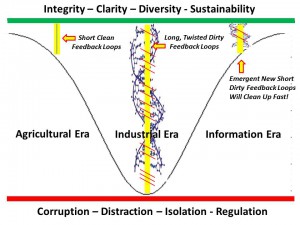
Source: 2013 Public Governance in the 21st Century: New Rules, Hybrid Forms, One Constant – The Public

Source: 2013 Public Governance in the 21st Century: New Rules, Hybrid Forms, One Constant – The Public
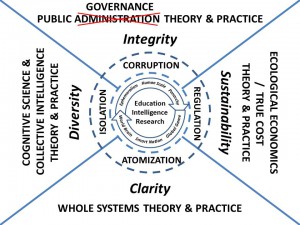
2013 Conference “Governance and the Utopian Imagination”
Though the term is most famously associated with Thomas More's Utopia (1516), the basic idea of imagining another, better world (eutopia, good place) that does not yet exist on Earth (utopia, no-place) is one with a long, rich history that touches perhaps all human societies and cultures. However over the course of the twentieth century, in some discourses utopianism and the utopian imagination came to be viewed as dangerous. They became associated not with dreams of a better world but with the most nightmarish, violent aspects of modernity and state-led efforts to make those dreams an actuality. In the wake of the collapse of state socialist projects and the rise in recent decades of what some call “market utopianism,” there has been a resurgence of interest and debate in the social sciences and humanities regarding utopian thought and the practical construction of “real utopias.” These efforts reconsider the role of utopian thought in human life in light of this history and seek workable alternatives to contemporary political, social, and economic governance.
This year's meeting of the Public Administration Theory Network seeks to re-engage “the utopian imagination” and invites contributions from across the social sciences, humanities, and fields of professional and community practice that critically explore the intersection of contemporary governance, utopia, and the human impulse to make better worlds.
I. Theoretical re-engagements with “utopia” that explore questions, such as:
–Can “utopia” be productively rehabilitated in light of history and critique? Or is it inextricably linked with Western hegemony and violence?
–How can or should traditions from the Global South, indigenous and native peoples, Asia, and elsewhere inform a re-examination of “Western” theories and experiences of utopianism?
–What role can or should government and public administration play in today's utopian imaginings?
II. Historical and/or genealogical analyses that explore utopia's intersection with: democracy, capitalism, liberalism, dystopia, colonialism, human nature, race, gender, sexuality, (anti-)globalization, innovation.
III. Critical explorations of contemporary sources of “utopian” and “dystopian” narrative and imagery and their relationship to matters of governance, such as: technology, management, environmentalism, economics, film, literature, philosophy, religion.
IV. Theoretically informed case studies that analyze the practical and institutional possibilities of moving from “utopian imagination” to building and governing “real utopias” and “intentional communities.”
RFP Flyer-short.pdf (99k) RFP Flyer-long.pdf (137k)
ACCEPTED FOR PRESENTATION: 2013 Public Governance in the 21st Century: New Rules, Hybrid Forms, One Constant – The Public

Optimizing Distributed Collaboration for Live Crisis Mapping
My colleague Duncan Watts recently spoke with Scientific American about a new project I am collaborating on with him & colleagues at Microsoft Research. I first met Duncan while at the Santa Fe Institute (SFI) back in 2006. We recently crossed paths again (at 10 Downing Street, of all places), and struck up a conver-sation about crisis mapping and the Standby Volunteer Task Force (SBTF). So I shared with him some of the challenges we were facing vis-a-vis the scaling up of our information processing workflows for digital humanitarian response. Duncan expressed a strong interest in working together to address some of these issues. As he told Scientific American, “We’d like to help them by trying to understand in a more scientific manner how to scale up information processing organizations like the SBTF without over-loading any part of the system.”
Online Social Science: Can the Web Graduate from Digital Petri Dish to Virtual Laboratory?
Social scientist Duncan Watts talks about how the Web can deliver on its decade-old promises of delivering researchers with unprecedented access to fodder for behavioral research
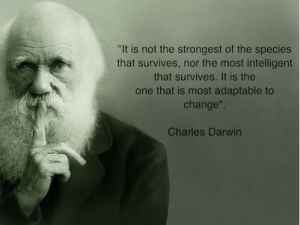
Tip of the Hat to Philosopher Rex at Google+.

As long as the strategy of “war on terrorism” remains the same, it's against the interests of the Pentagon to admit their strategy isn't working. In theory that could embolden the enemy. But let's look at two sides of that. The enemy seems to know better than we do how futile our strategy is in the long run. What they don't know is how long we'll be committed to it. So if the Pentagon were to publicly admit their strategy isn't working, that would be a sign that they may be on the verge of abandoning it, which could be useful information for the enemy. It could lead them to change their strategy.
Unfortunately this dynamic leaves Bush and Cheney with the perfect excuse for not admitting that their war policies were perhaps the most disastrous decisions made in American history. So it's very convenient for them. To publicly admit their enormous errors could have a negative effect on the war effort. That lets them off the hook.
But it also prevents America and Americans from learning from our mistakes. And this has been the dynamic since the end of World War II. Our policies in the Middle East have caused blowback on a scale that's unmeasurable. The war between Islamists and the West may not exist otherwise. And this war is shaping up to be far more complex than a war against communism, because the front lines aren't as clearly marked and terrorist can be anywhere.
After Eisenhower resolved the Suez Crisis, Arabs in the Middle East were cheering and holding up signs that said We Love America. How times have changed.

How the UN Used Social Media in Response to Typhoon Pablo
Our mission as digital humanitarians was to deliver a detailed dataset of pictures and videos (posted on Twitter) which depicted the damage and flooding following the Typhoon. An overview of this digital response is available here. The task of our United Nations colleagues at the Office of the Coordination of Humanitarian Affairs (OCHA), was to rapidly consolidate and analyze our data to compile a customized Situation Report for OCHA’s team in the Philippines. The maps, charts and figures below are taken from this official report (click to enlarge).
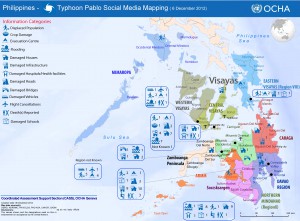
This map is the first ever official UN crisis map entirely based on data collected from social media.
One of my main priorities now is to make sure we do a far better job at leveraging advanced computing and microtasking platforms so that we are better prepared the next time we’re asked to repeat this kind of deployment. On the advanced computing side, it should be perfectly feasible to develop an automated way to crawl twitter and identify links to images and videos.
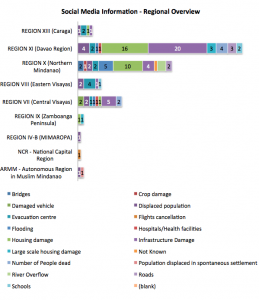
My colleagues at QCRI are already looking into this. As for microtasking, I am collaborating with PyBossa and Crowdflower to ensure that we have highly customizable platforms on stand-by so we can immediately upload the results of QCRI’s algorithms. In sum, we have got to move beyond simple crowdsourcing and adopt more agile micro-tasking and social computing platforms as both are far more scalable.
One of my main priorities now is to make sure we do a far better job at leveraging advanced computing and microtasking platforms so that we are better prepared the next time we’re asked to repeat this kind of deployment. On the advanced computing side, it should be perfectly feasible to develop an automated way to crawl twitter and identify links to images and videos.
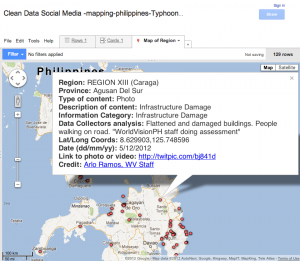 My colleagues at QCRI are already looking into this. As for microtasking, I am collaborating with PyBossa and Crowdflower to ensure that we have highly customizable platforms on stand-by so we can immediately upload the results of QCRI’s algorithms. In sum, we have got to move beyond simple crowdsourcing and adopt more agile micro-tasking and social computing platforms as both are far more scalable.
My colleagues at QCRI are already looking into this. As for microtasking, I am collaborating with PyBossa and Crowdflower to ensure that we have highly customizable platforms on stand-by so we can immediately upload the results of QCRI’s algorithms. In sum, we have got to move beyond simple crowdsourcing and adopt more agile micro-tasking and social computing platforms as both are far more scalable.